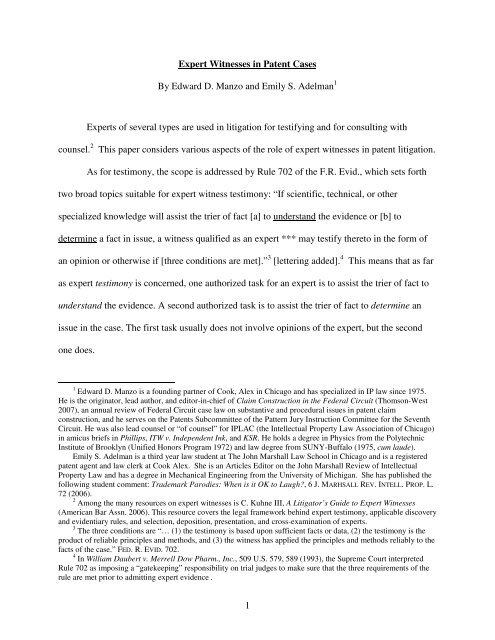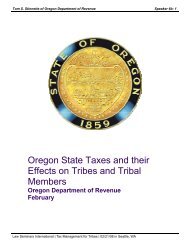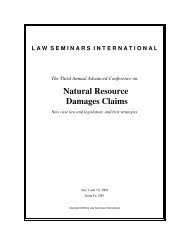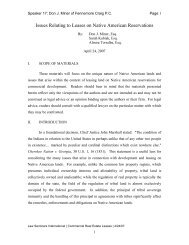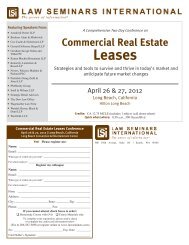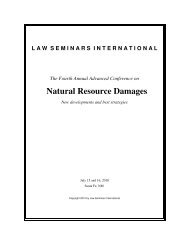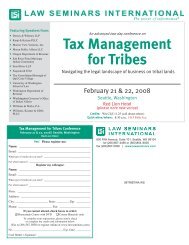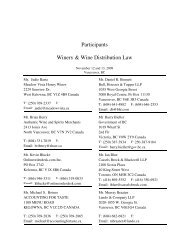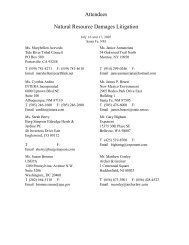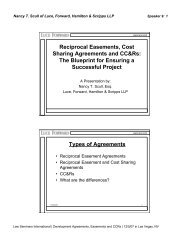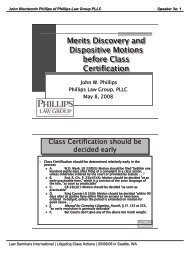1 Expert Witnesses in Patent Cases By Edward D. Manzo and Emily ...
1 Expert Witnesses in Patent Cases By Edward D. Manzo and Emily ...
1 Expert Witnesses in Patent Cases By Edward D. Manzo and Emily ...
Create successful ePaper yourself
Turn your PDF publications into a flip-book with our unique Google optimized e-Paper software.
<strong>Expert</strong> <strong>Witnesses</strong> <strong>in</strong> <strong>Patent</strong> <strong>Cases</strong><br />
<strong>By</strong> <strong>Edward</strong> D. <strong>Manzo</strong> <strong>and</strong> <strong>Emily</strong> S. Adelman 1<br />
<strong>Expert</strong>s of several types are used <strong>in</strong> litigation for testify<strong>in</strong>g <strong>and</strong> for consult<strong>in</strong>g with<br />
counsel. 2<br />
This paper considers various aspects of the role of expert witnesses <strong>in</strong> patent litigation.<br />
As for testimony, the scope is addressed by Rule 702 of the F.R. Evid., which sets forth<br />
two broad topics suitable for expert witness testimony: “If scientific, technical, or other<br />
specialized knowledge will assist the trier of fact [a] to underst<strong>and</strong> the evidence or [b] to<br />
determ<strong>in</strong>e a fact <strong>in</strong> issue, a witness qualified as an expert *** may testify thereto <strong>in</strong> the form of<br />
an op<strong>in</strong>ion or otherwise if [three conditions are met].” 3 [letter<strong>in</strong>g added]. 4<br />
This means that as far<br />
as expert testimony is concerned, one authorized task for an expert is to assist the trier of fact to<br />
underst<strong>and</strong> the evidence. A second authorized task is to assist the trier of fact to determ<strong>in</strong>e an<br />
issue <strong>in</strong> the case. The first task usually does not <strong>in</strong>volve op<strong>in</strong>ions of the expert, but the second<br />
one does.<br />
1 <strong>Edward</strong> D. <strong>Manzo</strong> is a found<strong>in</strong>g partner of Cook, Alex <strong>in</strong> Chicago <strong>and</strong> has specialized <strong>in</strong> IP law s<strong>in</strong>ce 1975.<br />
He is the orig<strong>in</strong>ator, lead author, <strong>and</strong> editor-<strong>in</strong>-chief of Claim Construction <strong>in</strong> the Federal Circuit (Thomson-West<br />
2007), an annual review of Federal Circuit case law on substantive <strong>and</strong> procedural issues <strong>in</strong> patent claim<br />
construction, <strong>and</strong> he serves on the <strong>Patent</strong>s Subcommittee of the Pattern Jury Instruction Committee for the Seventh<br />
Circuit. He was also lead counsel or “of counsel” for IPLAC (the Intellectual Property Law Association of Chicago)<br />
<strong>in</strong> amicus briefs <strong>in</strong> Phillips, ITW v. Independent Ink, <strong>and</strong> KSR. He holds a degree <strong>in</strong> Physics from the Polytechnic<br />
Institute of Brooklyn (Unified Honors Program 1972) <strong>and</strong> law degree from SUNY-Buffalo (1975, cum laude).<br />
<strong>Emily</strong> S. Adelman is a third year law student at The John Marshall Law School <strong>in</strong> Chicago <strong>and</strong> is a registered<br />
patent agent <strong>and</strong> law clerk at Cook Alex. She is an Articles Editor on the John Marshall Review of Intellectual<br />
Property Law <strong>and</strong> has a degree <strong>in</strong> Mechanical Eng<strong>in</strong>eer<strong>in</strong>g from the University of Michigan. She has published the<br />
follow<strong>in</strong>g student comment: Trademark Parodies: When is it OK to Laugh?, 6 J. MARHSALL REV. INTELL. PROP. L.<br />
72 (2006).<br />
2 Among the many resources on expert witnesses is C. Kuhne III, A Litigator’s Guide to <strong>Expert</strong> <strong>Witnesses</strong><br />
(American Bar Assn. 2006). This resource covers the legal framework beh<strong>in</strong>d expert testimony, applicable discovery<br />
<strong>and</strong> evidentiary rules, <strong>and</strong> selection, deposition, presentation, <strong>and</strong> cross-exam<strong>in</strong>ation of experts.<br />
3 The three conditions are “… (1) the testimony is based upon sufficient facts or data, (2) the testimony is the<br />
product of reliable pr<strong>in</strong>ciples <strong>and</strong> methods, <strong>and</strong> (3) the witness has applied the pr<strong>in</strong>ciples <strong>and</strong> methods reliably to the<br />
facts of the case.” FED. R. EVID. 702.<br />
4 In William Daubert v. Merrell Dow Pharm., Inc., 509 U.S. 579, 589 (1993), the Supreme Court <strong>in</strong>terpreted<br />
Rule 702 as impos<strong>in</strong>g a “gatekeep<strong>in</strong>g” responsibility on trial judges to make sure that the three requirements of the<br />
rule are met prior to admitt<strong>in</strong>g expert evidence .<br />
1
What are the roles of testify<strong>in</strong>g experts <strong>in</strong> patent cases? <strong>Patent</strong> cases <strong>in</strong>herently <strong>in</strong>volve<br />
assertions about technology – what the <strong>in</strong>vention is (claim construction), whether it is used<br />
(<strong>in</strong>fr<strong>in</strong>gement), whether it meets conditions for patentability (validity), <strong>and</strong> on occasion whether<br />
there are issues over the disclosures to the <strong>Patent</strong> <strong>and</strong> Trademark Office (PTO) – be they<br />
regard<strong>in</strong>g prior art, test<strong>in</strong>g, etc. As such, patent cases <strong>in</strong>volve subject matter that is often the<br />
subject of specialized knowledge <strong>and</strong> hence are fertile ground for the use of experts. Hence,<br />
these traditional topics addressed by experts <strong>in</strong> patent cases are: (1) to prove or disprove<br />
<strong>in</strong>fr<strong>in</strong>gement, (2) to prove patent <strong>in</strong>validity or rebut such attacks, <strong>and</strong> occasionally (3) to<br />
comment on practices <strong>and</strong> procedures <strong>in</strong> prosecut<strong>in</strong>g patents before the USPTO.<br />
The pla<strong>in</strong>tiff’s burden is not only to show liability but also to prove <strong>and</strong> quantify damages<br />
<strong>in</strong> a non-speculative way. The patent statute provides for damages not less than a reasonable<br />
royalty, but it also allows lost profits <strong>in</strong> appropriate cases. One ord<strong>in</strong>arily uses an expert to<br />
quantify damages, <strong>and</strong> hence we add (4) to establish the amount of damages.<br />
In these four uses, the expert is presented for purposes of help<strong>in</strong>g to persuade the trier of<br />
fact. This list of four customary experts is not complete. <strong>Patent</strong> cases are lawsuits <strong>and</strong> as such<br />
further expertise can be brought to bear beyond the attorney’s arguments <strong>and</strong> presentations.<br />
Currently, one should also engage (5) an expert on electronic forensics to assist with document<br />
discovery, production, <strong>and</strong> related issues. Two further uses of an expert witness are: (6) <strong>in</strong><br />
prepar<strong>in</strong>g <strong>and</strong> present<strong>in</strong>g a technology tutorial dur<strong>in</strong>g (or before) the claim construction phase of<br />
the case, <strong>and</strong> (7) <strong>in</strong> preparation of demonstrative exhibits, which can relate to any or all of the<br />
topics mentioned already.<br />
Some of these experts will be testify<strong>in</strong>g while others need not. A 1996 article by Molloy<br />
et al. (“Molloy”) on the use of experts po<strong>in</strong>ts out how an expert may be used <strong>in</strong> general, not<strong>in</strong>g<br />
2
these reasons that are not specific to patent cases but are nevertheless certa<strong>in</strong>ly valid<br />
observations:<br />
(1) to assist you <strong>in</strong> learn<strong>in</strong>g the subject matter <strong>in</strong> issue;<br />
(2) to assess the record for completeness;<br />
(3) to identify issues otherwise missed;<br />
(4) to assist you <strong>in</strong> draft<strong>in</strong>g <strong>in</strong>terrogatories <strong>and</strong> requests for production by<br />
suggest<strong>in</strong>g questions to ask <strong>and</strong> <strong>in</strong>formation <strong>in</strong> request;<br />
(5) to respond to expert <strong>in</strong>terrogatories;<br />
(6) to evaluate your opponent's response to <strong>in</strong>terrogatories;<br />
(7) to assist you <strong>in</strong> prepar<strong>in</strong>g to depose <strong>and</strong> cross-exam<strong>in</strong>e oppos<strong>in</strong>g counsel's<br />
expert;<br />
(8) to draft technical questions for use <strong>in</strong> question<strong>in</strong>g the oppos<strong>in</strong>g party <strong>and</strong> the<br />
oppos<strong>in</strong>g expert;<br />
(9) to sit <strong>in</strong> on or otherwise evaluate the deposition of the oppos<strong>in</strong>g party <strong>and</strong> the<br />
oppos<strong>in</strong>g expert; <strong>and</strong><br />
(10) to help frame the direction from which you will present evidence. 5<br />
Molloy’s 10 observations relate to use of the expert after litigation has commenced, but an expert<br />
can also be used before suit is filed. An expert can help to assess the case. For example, a<br />
prospective pla<strong>in</strong>tiff may turn to experts to evaluate the merits of the <strong>in</strong>fr<strong>in</strong>gement case, identify<br />
potential weaknesses <strong>in</strong> the validity of the patent, <strong>and</strong> give some idea about damages. For a<br />
company that is aware of an <strong>in</strong>fr<strong>in</strong>gement charge or an adversely-held patent that has a chance of<br />
be<strong>in</strong>g asserted <strong>in</strong> litigation, counsel may engage an expert to identify <strong>and</strong> evaluate defenses.<br />
A. Characteristics of <strong>Expert</strong> <strong>Witnesses</strong><br />
The characteristics of a good expert witness follow from the contemplated task <strong>and</strong> the<br />
audience the expert is expected to serve. Select<strong>in</strong>g a testify<strong>in</strong>g expert <strong>in</strong>volves a host of factors<br />
that simply do not apply when the expert is hired to assess the case, educate the lawyer, prepare a<br />
5<br />
Maureen K. Molloy, Patricia S. Orr & Lawrence D. Copp, Five Steps to Us<strong>in</strong>g <strong>Expert</strong> <strong>Witnesses</strong> Effectively,<br />
22 VERMONT BAR J. & L. DIG. 14, 16 (1996).<br />
3
tutorial, prepare exhibits, assist with discovery, or testify <strong>in</strong> declarations to be filed with the court<br />
on why an adversary’s electronic discovery is deficient or why the adversary has spoiled the<br />
evidence.<br />
When it comes to testify<strong>in</strong>g experts, common sense is a good guide. You want the expert<br />
to help conv<strong>in</strong>ce the judge or jury that your position is correct (<strong>and</strong> that your opponent’s is<br />
wrong). From this perspective, the best expert is the one who is most persuasive. Such an expert<br />
(a) has been qualified by a court, (b) has actually testified at trial many times before, possibly on<br />
your technology or on your po<strong>in</strong>t, <strong>and</strong> (c) has generally persuaded the jury <strong>in</strong> his or her favor<br />
(<strong>and</strong> whose testimony has withstood appellate review).<br />
However, to exp<strong>and</strong> that a bit <strong>and</strong> apply a more rigorous approach, the authors of one law<br />
review article analyzed <strong>in</strong>terviews of over 200 jurors <strong>in</strong> 36 civil cases <strong>and</strong> developed a<br />
comprehensive model of the key factors that jurors consider when they are judg<strong>in</strong>g the credibility<br />
of an expert witness. 6<br />
This research revealed that what makes an expert a good one does not<br />
depend on any s<strong>in</strong>gle characteristic. 7<br />
Instead, jurors associated the follow<strong>in</strong>g characteristics with<br />
credible testimony:<br />
• lack of bias;<br />
6 Sanja Kutnjak Ivkovic & Valerie P. Hans, Jurors’ Evaluations of <strong>Expert</strong> Testimony: Judg<strong>in</strong>g the Messenger<br />
<strong>and</strong> the Message, 28 LAW & SOC. INQUIRY 441 (2003). This law review article made the follow<strong>in</strong>g analogy<br />
regard<strong>in</strong>g expert witnesses:<br />
[E]xpert witness<strong>in</strong>g may be characterized as a ‘performance.’ Lawyers commission <strong>and</strong> direct<br />
these presentations. The determ<strong>in</strong>ants of the performance beg<strong>in</strong> with the lawyer’s choice of a<br />
performer (cast<strong>in</strong>g) <strong>and</strong> proceed to the content of the testimony (script) <strong>and</strong> the manner of<br />
presentation (stag<strong>in</strong>g). If these efforts are successful, the audience’s perceptions of the messenger<br />
<strong>and</strong> the message unite to form their reaction to a performance that is designed to have a specific<br />
impact – like the <strong>in</strong>tertw<strong>in</strong><strong>in</strong>g of character <strong>and</strong> plot <strong>in</strong> a play. As we learn more about how jurors<br />
respond to experts, it is worthwhile to keep <strong>in</strong> m<strong>in</strong>d that the dimensions of expert performance are<br />
chosen <strong>and</strong> created with the aim of <strong>in</strong>fluenc<strong>in</strong>g jury decision mak<strong>in</strong>g. Arguably, one important<br />
function of adversarial cross-exam<strong>in</strong>ation is to help jurors pull back the curta<strong>in</strong> on the performance<br />
of an expert witness. Research that exam<strong>in</strong>es the relative effects of credentials, motives,<br />
presentation style, <strong>and</strong> content on expert credibility may show more fully how jurors judge the<br />
expert performance presented to them.<br />
Id. at 480.<br />
7 Ivkovic, supra note 6, at 445.<br />
4
• good credentials;<br />
• a pleasant personality;<br />
• a clear, objective, focused, not overly long presentation that utilizes diagrams <strong>and</strong><br />
models;<br />
• use of lay terms;<br />
• a presentation that is complete, consistent, <strong>and</strong> not too complex;<br />
• knowledgeability <strong>in</strong> the area of expertise; <strong>and</strong><br />
• familiarity with the case. 8<br />
Jurors who were <strong>in</strong>terviewed also gave their op<strong>in</strong>ions as to qualities that they associated<br />
with bad expert witnesses. Bad witnesses:<br />
• are bor<strong>in</strong>g,<br />
• make it obvious that they are there because they are be<strong>in</strong>g paid,<br />
• do not know much about the case or its issues, <strong>and</strong><br />
• get flustered or overly defensive on cross-exam<strong>in</strong>ation. 9<br />
“Bad” experts also <strong>in</strong>clude ones who are evasive on cross-exam<strong>in</strong>ation when they try to<br />
get around a question or start giv<strong>in</strong>g a big explanation for someth<strong>in</strong>g that the jury does not<br />
underst<strong>and</strong>. 10<br />
An overly-long list of credentials could also underm<strong>in</strong>e the credibility of an expert<br />
witness. 11<br />
A jury may f<strong>in</strong>d that a long list of credentials <strong>in</strong>dicates that the person does not have<br />
time to actually practice <strong>in</strong> the field of their supposed expertise. Furthermore, a long list of<br />
publications by the expert does not necessarily guarantee that the expert has much practical<br />
expertise <strong>and</strong> experience <strong>in</strong> the field. Prior publications may conta<strong>in</strong> conflict<strong>in</strong>g portions that<br />
will be open for exploitation by oppos<strong>in</strong>g counsel. 12<br />
Practical experience <strong>and</strong> actual knowledge<br />
8 Ivkovic, supra note 6, at 458 (stat<strong>in</strong>g that the jurors ranked presentation style as the most important factor to<br />
credibility; credentials came <strong>in</strong> second while general impressions of the expert came <strong>in</strong> third).<br />
9 Ivkovic, supra note 6, at 457.<br />
10 Ivkovic, supra note 6, at 471.<br />
11 Ivkovic, supra note 6, at 462-63.<br />
12 Damages Analysis <strong>and</strong> <strong>Expert</strong> Testimony: Avoid<strong>in</strong>g Common Mistakes when Select<strong>in</strong>g an <strong>Expert</strong> Witness,<br />
available at fulcrum<strong>in</strong>quiry.com/Select<strong>in</strong>g_an_<strong>Expert</strong>_Witness.htm [here<strong>in</strong>after Damages Analysis].<br />
5
are more important than paper qualifications. 13<br />
The average expert witness is 50 years old,<br />
which suggests that experience over time is of major importance <strong>in</strong> an expert’s qualifications. 14<br />
How the testify<strong>in</strong>g expert speaks is also a very important factor. The expert must use<br />
layman’s terms <strong>and</strong> provide a well paced presentation. 15<br />
In other words, powerful language <strong>and</strong><br />
avoid<strong>in</strong>g jargon <strong>and</strong> long narratives makes for more effective expert witnesses. 16<br />
An expert with<br />
the natural ability to use layman’s terms will probably have some teach<strong>in</strong>g experience. The<br />
expert witness must be able to teach very complex <strong>and</strong> technical issues to the jury. An expert<br />
with teach<strong>in</strong>g experience, especially <strong>in</strong> the area of the case, will be able to expla<strong>in</strong> these issues <strong>in</strong><br />
a clear <strong>and</strong> concise manner. “Who is better qualified to teach a jury, than a qualified teacher?” 17<br />
(On the other h<strong>and</strong>, one who does noth<strong>in</strong>g but teach may have difficulties <strong>in</strong> cross exam<strong>in</strong>ation<br />
directed to the lack of practical, field experience. See below.)<br />
Communication skills are not the only characteristic that the jury will notice. Body<br />
language, attitude, carriage, facial expressions, gestures, appearance, <strong>and</strong> shrugs <strong>and</strong> nods also<br />
play a crucial role. 18<br />
An expert witness who appears confident, but is not demean<strong>in</strong>g, will have<br />
the most effective testimony.<br />
13<br />
James S. Schultz, Juries: Arbiters or Arbitrary?: Redef<strong>in</strong><strong>in</strong>g the Role of the Jury: The <strong>Expert</strong> Witness <strong>and</strong><br />
Jury Comprehension: An <strong>Expert</strong>’s Perspective, 7 CORNELL J. L. & PUB. POL’Y 107, 113 (1997).<br />
14<br />
Bernalyn D. McGaughey, The Role <strong>and</strong> Responsibility of an <strong>Expert</strong> Witness, 3 DRAKE J. AGRIC. L. 227<br />
(1998).<br />
15 Accord<strong>in</strong>g to one study:<br />
Jargon is much more extensive than many experts realize. About 15% of the typical jury pool does<br />
not know what a percentage is. They do not know it must add up to 100. Similarly, what is a<br />
"mean"? . . . "Hostile environment" is viewed by many jurors as <strong>in</strong>clud<strong>in</strong>g anyth<strong>in</strong>g that they do<br />
not like about the workplace. This is a reasonable <strong>in</strong>ference based on the everyday use of the word<br />
. . . . Jurors ask over <strong>and</strong> over aga<strong>in</strong>, "Why can't they just tell us <strong>in</strong> pla<strong>in</strong> English what this all<br />
means?"<br />
Cynthia H. Cwik, Guard<strong>in</strong>g the Gate: <strong>Expert</strong> Evidence Admissibility, 25 A.B.A. LITIGATION 6 (1999).<br />
16<br />
Steven Lubet, <strong>Expert</strong> <strong>Witnesses</strong>: Ethics <strong>and</strong> Professionalism, 12 GEO. J. LEGAL ETHICS 465, 471 (1999).<br />
17 David Theodore Tirella, W<strong>in</strong>n<strong>in</strong>g Strategies: The Four Ps of <strong>Expert</strong> Witness Selection, 80 FLA. BAR J. 65, 66<br />
(2006). The top four qualifications an expert can have is that they are a practitioner, a professor, has published peerreviewed<br />
articles, textbooks, or guidel<strong>in</strong>es, <strong>and</strong> presents well <strong>in</strong> front of a jury. Id. at 65.<br />
18 Jeffrey L. Baliban, 13 th Annual Guide to <strong>Expert</strong> <strong>Witnesses</strong>: What Counts <strong>in</strong> Select<strong>in</strong>g an <strong>Expert</strong>, 24 LOS<br />
ANGELES LAWYER 48 (2001).<br />
6
Many of these factors are <strong>in</strong>applicable to experts who are not <strong>in</strong>tended to testify. <strong>Expert</strong>s<br />
on electronic discovery, computer systems, <strong>and</strong> the like need not have jury appeal. <strong>Expert</strong>s who<br />
prepare technology tutorials to be delivered to the judge, <strong>and</strong> preparers of demonstrative exhibits<br />
also need not have jury appeal. On the other h<strong>and</strong>, the Federal Circuit does permit district courts<br />
to receive expert testimony on claim construction issues, which often <strong>in</strong>cludes technology<br />
tutorials, <strong>and</strong> that “evidence” may sometimes be presented live. In such a case, the lawyer must<br />
consider persuasiveness to the court (not the jury – as claim construction issues are not for jury<br />
consideration).<br />
An expert can also be used, however, to educate the jury about the technology that it is<br />
go<strong>in</strong>g to consider. A judge may allow a witness to present a technology tutorial for the jury – not<br />
a claim construction tutorial. Here aga<strong>in</strong>, some jury appeal is desirable, although experts who<br />
present such technology tutorials are not giv<strong>in</strong>g op<strong>in</strong>ions, <strong>and</strong> the jury probably will not need to<br />
address their credibility. Moreover, it is not genu<strong>in</strong>ely likely that the parties will have a true<br />
dispute over what the background technology is <strong>in</strong> their case. One district court op<strong>in</strong>ion<br />
expla<strong>in</strong>ed why the receipt of expert testimony regard<strong>in</strong>g the technology <strong>in</strong> general was permitted,<br />
overrul<strong>in</strong>g objections under F.R. Evid. 702 <strong>and</strong> not<strong>in</strong>g that experts need not express nor even<br />
hold an op<strong>in</strong>ion with regard to the issues <strong>in</strong>volved at trial, but that <strong>in</strong>stead the key concern is<br />
whether expert testimony will assist the trier of fact <strong>in</strong> draw<strong>in</strong>g its own conclusion. An expert<br />
may expla<strong>in</strong> pr<strong>in</strong>ciples without apply<strong>in</strong>g them or offer<strong>in</strong>g an op<strong>in</strong>ion on the ultimate issue. 19<br />
Indeed, the Advisory Committee notes to Rule 702 <strong>in</strong>dicate that it can be “important <strong>in</strong> some<br />
19 Fresenius Medical Care Hold<strong>in</strong>gs, Inc. v. Baxter International, Inc., 2006 WL 1329999 (N.D. Cal. 2006) at<br />
*5 cit<strong>in</strong>g U.S. v. Rahm, 993 F.2d 1405, 1411 (9th Cir. 1993); Smith v. Ford Motor Co., 215 F.3d 713, 718 (7th Cir.<br />
2000); <strong>and</strong> Erickson v. Baxter Healthcare, Inc., 151 F.Supp.2d 952, 968 (N.D. Ill. 2001).<br />
7
cases for an expert to educate the factf<strong>in</strong>der about general pr<strong>in</strong>ciples, without ever attempt<strong>in</strong>g to<br />
apply these pr<strong>in</strong>ciples to the specific facts of the case.” 20<br />
Note that an economical alternative to hir<strong>in</strong>g an expert to expla<strong>in</strong> the background is to<br />
use the <strong>in</strong>ventor herself, provided she is well-spoken, communicative, preferably animated, <strong>and</strong><br />
knowledgeable.<br />
B. Select<strong>in</strong>g <strong>Expert</strong> <strong>Witnesses</strong><br />
The start<strong>in</strong>g po<strong>in</strong>t <strong>in</strong> select<strong>in</strong>g the expert witnesses is determ<strong>in</strong><strong>in</strong>g what issues require or<br />
would benefit from expert witnesses <strong>and</strong> what your budget is like. There are cases where an<br />
expert witness might be helpful but the cost is outside the budget. On the other h<strong>and</strong>, many<br />
patent cases are sufficiently important that allowances must be made for expert witness costs <strong>in</strong><br />
the budget. Other cases are so important that the budget is a secondary concern at best. The<br />
lawyer will need to consult with the client on recommendations <strong>and</strong> monetary constra<strong>in</strong>ts. As<br />
just noted, sometimes an <strong>in</strong>-house witness can attend to simple tasks relatively economically.<br />
They are, however, <strong>in</strong>herently biased <strong>and</strong> become exposed to cross-exam<strong>in</strong>ation where their<br />
shortcom<strong>in</strong>gs can be exposed. Manag<strong>in</strong>g the costs of expert witnesses is discussed <strong>in</strong>fra.<br />
1. <strong>Expert</strong> Teams or a Sole <strong>Expert</strong> for Each Issue?<br />
Once the issues are determ<strong>in</strong>ed, a further question is whether a s<strong>in</strong>gle expert or a team of<br />
experts can be used on any given issue. One may choose a team of experts or a sole expert for<br />
certa<strong>in</strong> issues. A redundant or back-up witness can sometimes be necessary. 21<br />
20 Committee Notes FED. R. EVID. 702.<br />
21<br />
Over a lawyer’s career, it is likely that an expert’s mortality will be a factor, <strong>and</strong> hav<strong>in</strong>g a back-up witness is<br />
beneficial. <strong>Expert</strong> witnesses are often somewhat older, <strong>and</strong> it is not at all uncommon for an expert to become<br />
<strong>in</strong>capacitated (or die) late <strong>in</strong> the litigation, between or dur<strong>in</strong>g depositions, <strong>and</strong> even dur<strong>in</strong>g trial. A provision for<br />
redundancy seems uneconomical but addresses this situation. Not every judge is will<strong>in</strong>g to stay a case for 4-8 weeks<br />
while counsel looks for a replacement expert <strong>and</strong> his or her deposition is taken. In addition, a replacement who has<br />
to work on a compressed time schedule may lose credibility for that circumstance alone.<br />
8
One danger with multiple experts on the same topic is that they may disagree with one<br />
another, <strong>and</strong> the disagreement might be discovered by the adversary. On the other h<strong>and</strong>, it is<br />
frequently the case that there is room for disagreement on most issues. If the testify<strong>in</strong>g witness<br />
discusses the case with anyone, that is discoverable. There is no “<strong>in</strong>ter-expert” privilege.<br />
a. Multiple Technologies Used As Prior Art<br />
Some issues have separable components, <strong>and</strong> <strong>in</strong> such <strong>in</strong>stances, a team of experts may be<br />
useful, each one focus<strong>in</strong>g on a particular segment of the task. For example, <strong>in</strong> a case that blends<br />
two technologies, it may be hard to f<strong>in</strong>d any s<strong>in</strong>gle <strong>in</strong>dividual who truly is an expert <strong>in</strong> the<br />
specific narrow field.<br />
Consider an example from the genesis of video games, many years ago, to be played on a<br />
television receiver. The prior art <strong>in</strong>cluded a “Star Wars” video game played on a Digital<br />
Equipment Company PDP computer by “hackers” (students, teach<strong>in</strong>g assistants) at MIT. The<br />
display they used was not a “raster scan” device but <strong>in</strong>stead a po<strong>in</strong>t display customarily used for<br />
computers (a po<strong>in</strong>t plott<strong>in</strong>g type of device, not raster scanned). Other prior art <strong>in</strong>volved a device<br />
that would accept po<strong>in</strong>t data <strong>and</strong> reformulate it as an electronic signal to deliver to a raster scan<br />
device, such as a television receiver (or monitor) for display. Here, a person of “ord<strong>in</strong>ary skill” <strong>in</strong><br />
programm<strong>in</strong>g video games (a computer hacker) was not an expert <strong>in</strong> video display technology,<br />
<strong>and</strong> vice-versa.<br />
In this <strong>in</strong>stance, an academic expert could be useful or a vice president of eng<strong>in</strong>eer<strong>in</strong>g<br />
may have been able to op<strong>in</strong>e authoritatively on the obviousness of comb<strong>in</strong><strong>in</strong>g these technologies.<br />
But <strong>in</strong> any event, that is one example where multiple experts could be called upon for their<br />
separate areas of expertise. This example would apply when different technologies are comb<strong>in</strong>ed<br />
<strong>in</strong> the (alleged) <strong>in</strong>vention. In these <strong>in</strong>stances, each witness testifies <strong>in</strong> a focused area, <strong>and</strong> one<br />
9
expert could testify on the comb<strong>in</strong>ation. Moreover, an expert <strong>in</strong> one technology probably would<br />
not even be qualified <strong>in</strong> the other technology <strong>and</strong> could not pass the gatekeeper requirements of<br />
Daubert.<br />
b. Separable Aspects of the Case<br />
In a case of suitable magnitude, counsel may have separate teams for the case-<strong>in</strong>-chief<br />
<strong>and</strong> the defensive case. That is, counsel for the patentee may have one team work<strong>in</strong>g on<br />
establish<strong>in</strong>g <strong>in</strong>fr<strong>in</strong>gement <strong>and</strong> another team defend<strong>in</strong>g validity <strong>and</strong> enforceability. The<br />
<strong>in</strong>fr<strong>in</strong>gement case <strong>in</strong>volves obta<strong>in</strong><strong>in</strong>g a detailed underst<strong>and</strong><strong>in</strong>g of the accused product, process, or<br />
composition <strong>and</strong> apply<strong>in</strong>g the claims of the patent, as <strong>in</strong>terpreted by the court, thereto.<br />
The defensive case deals ma<strong>in</strong>ly with rebutt<strong>in</strong>g attacks on the patent, usually based on<br />
prior art. This second aspect of the case could be done by the same expert but it could also be<br />
delegated to a separate team of lawyers <strong>and</strong> expert(s). An important po<strong>in</strong>t for the pla<strong>in</strong>tiff will be<br />
to ensure that one expert does not contradict the other. Defense counsel will try to get the<br />
<strong>in</strong>fr<strong>in</strong>gement witness to read claims on the prior art <strong>and</strong> will try to get the validity expert to<br />
identify the accused product, process, or composition with the prior art. The experts have to be<br />
prepared for these attacks.<br />
c. An <strong>Expert</strong> with Support Staff<br />
On damages, a team approach is commonly used <strong>and</strong> has economic advantages. The<br />
damages analysis requires so much study <strong>and</strong> analysis that it is not economical for a high-priced<br />
testify<strong>in</strong>g expert witness to h<strong>and</strong>le all of the analysis personally. Usually, a damages expert<br />
works with a team with<strong>in</strong> his own organization. Sometimes the organization provides a blended<br />
bill<strong>in</strong>g rate for this service, <strong>and</strong> that s<strong>in</strong>gle rate applies to all hours logged. In such <strong>in</strong>stances, less<br />
10
senior experts will be do<strong>in</strong>g much of the background study, while the more senior expert will be<br />
slotted for review, oversee<strong>in</strong>g the expert report, <strong>and</strong> giv<strong>in</strong>g all testimony.<br />
d. Cost Factors<br />
Few clients tell litigation counsel to spend liberally on anyth<strong>in</strong>g – experts <strong>in</strong>cluded. Yet,<br />
counsel occasionally are told by clients that a given case is vital to the core (or only) bus<strong>in</strong>ess of<br />
the company or that an adverse outcome of the case will be a mortal blow to corporate growth or<br />
survival. Such cases generally call for a less restrictive litigation budget. More often, however,<br />
clients are <strong>in</strong>terested <strong>in</strong> low litigation costs.<br />
Sometimes, one can avoid hir<strong>in</strong>g certa<strong>in</strong> experts. Two examples will illustrate this.<br />
EXAMPLE 1: In some simple patent cases, prov<strong>in</strong>g <strong>in</strong>fr<strong>in</strong>gement<br />
does not require expert testimony because the issue does not<br />
require scientific, technical or specialized knowledge to determ<strong>in</strong>e.<br />
This is more likely to be true <strong>in</strong> simple mechanical cases than <strong>in</strong><br />
other types of cases, or where one can make out an <strong>in</strong>fr<strong>in</strong>gement<br />
case largely through admissions of adverse technical witnesses or<br />
documents of the adversary. The issue can be resolved based on<br />
common observations with<strong>in</strong> the grasp of the lay juror. (For<br />
example, does the conveyor make a turn? Does an apparatus<br />
<strong>in</strong>clude a certa<strong>in</strong> structure? Does the accused product embody<br />
features of a patented design to such an extent that one would be<br />
confused between the patented design <strong>and</strong> the accused product?)<br />
Fact witnesses can be sufficient to address the issues, avoid<strong>in</strong>g<br />
expert witness costs. Defense counsel, on the other h<strong>and</strong>, may need<br />
expert witnesses to expla<strong>in</strong> persuasively why what seems evident<br />
is <strong>in</strong> fact not the case.<br />
EXAMPLE 2: If you represent a patent owner <strong>and</strong> the real remedy<br />
your client seeks is <strong>in</strong>junctive relief, e.g., if damages for past acts<br />
are small, then it makes little sense to spend perhaps $100,000 to<br />
calculate that you have been damaged by $10,000. You might<br />
forsake calculat<strong>in</strong>g past damages. Of course, <strong>in</strong> eBay Inc. v.<br />
MercExchange, L.L.C., 126 S.Ct. 1837 (May 15, 2006), a<br />
unanimous Supreme Court rejected the “general rule” of the<br />
Federal Circuit that a permanent <strong>in</strong>junction should issue after<br />
patent <strong>in</strong>fr<strong>in</strong>gement is judicially established, except <strong>in</strong><br />
extraord<strong>in</strong>ary situations. Some courts have denied permanent<br />
<strong>in</strong>junctions even after a pla<strong>in</strong>tiff establishes not only liability but<br />
11
also that the <strong>in</strong>fr<strong>in</strong>gement was willful. 22 The court may award<br />
relief aga<strong>in</strong>st future damages <strong>in</strong> the form of a royalty – effectively<br />
a compulsory license. An expert should be useful <strong>in</strong> establish<strong>in</strong>g<br />
what would be reasonable under the circumstances. Bifurcation<br />
might be desired to avoid costs of the economic expert witness.<br />
You may sometimes have no choice but to call upon your adversary’s expert(s). While<br />
this is without cost, it is not a suggested strategy <strong>and</strong> should be attempted only when utterly<br />
necessary – for example when your own expert becomes <strong>in</strong>capacitated, dies, or her testimony is<br />
rejected under Daubert. Your opponent’s expert may have to choose between answer<strong>in</strong>g<br />
truthfully, aga<strong>in</strong>st the <strong>in</strong>terests of the party hir<strong>in</strong>g him, or answer<strong>in</strong>g falsely <strong>and</strong> los<strong>in</strong>g<br />
credibility. The follow<strong>in</strong>g is an example:<br />
EXAMPLE 3: Your client is pla<strong>in</strong>tiff <strong>in</strong> a patent <strong>in</strong>fr<strong>in</strong>gement suit<br />
<strong>and</strong> runs out of fund<strong>in</strong>g for the suit. The client advises you that<br />
only $10,000 is available for expert witnesses. After advis<strong>in</strong>g the<br />
client of the enormous risks <strong>in</strong> this, if counsel decides not to<br />
withdraw from representation but to cont<strong>in</strong>ue, the client decides<br />
not to offer expert testimony on damages <strong>in</strong> the case <strong>in</strong> chief. A<br />
client representative will testify as to the pla<strong>in</strong>tiff’s profit marg<strong>in</strong>s,<br />
licens<strong>in</strong>g position, past licens<strong>in</strong>g, lost sales, <strong>and</strong> state of the<br />
market, <strong>and</strong> will try to quantify damages. The defendant’s damages<br />
expert is expected to testify that the amount is too high by an order<br />
of magnitude. You plan to cross exam<strong>in</strong>e that adverse witness to<br />
establish that there is room for disagreement as to the amount <strong>and</strong><br />
that your own witness’ posited amount is different from the<br />
expert’s view but still with<strong>in</strong> reason, based on accepted pr<strong>in</strong>ciples.<br />
The reason for the difference may depend on a simple fact<br />
determ<strong>in</strong>able by the jury, such as whether your client would<br />
capture more of the lost sales than the defendant’s expert says.<br />
22 KEG Technologies Inc. v. Laimar, 436 F.Supp.2d 1364 (N.D. Ga. June 8, 2006); Z4 Technologies, Inc. v.<br />
Microsoft Corp., 434 F.Supp.2d 437 (E.D. Tex. June 14, 2006); F<strong>in</strong>isar Corporation v. The DirecTV Group, Inc.,<br />
2006 U.S. Dist. LEXIS 76380 (E.D. Tex., July 7, 2006); Paice LLC v. Toyota Motor Corp., 2006 WL 2385139<br />
(E.D. Tex. Aug. 16, 2006); Voda v. Cordis Corp., 2006 WL 2570614 (W.D. Okla. Sept. 5, 2006); Sundance, Inc. v.<br />
DeMonte Fabricat<strong>in</strong>g Ltd., 2007 WL 37742 (E.D. Mich. Jan. 4, 2007); IMX v. Lend<strong>in</strong>gTree, LLC, 469 F.Supp.2d<br />
203 (D. Del. Jan. 10, 2007); Praxair, Inc. v. ATMI, Inc., 479 F.Supp.2d 440 (D. Del. March 27, 2007); Baden<br />
Sports, Inc. v. Molten, 2007 WL 2056402 (W.D. Wash. July 16, 2007); <strong>and</strong> MercExchange LLC v. eBay, __<br />
F.Supp.2d __, 2007 WL 2172587 (E.D. Va. July 27, 2007).<br />
12
Outside these extreme conditions, one can still reduce expert witness costs <strong>in</strong> patent<br />
cases. When a cost-cutt<strong>in</strong>g client requires a testify<strong>in</strong>g expert, counsel may look to less<br />
experienced or less-credentialed c<strong>and</strong>idates who will still do good work <strong>and</strong> be presentable. Not<br />
every expert whose testimony will meet Rule 702, F.R. Evid., charges top rates. A jury may<br />
forgive less experience <strong>in</strong> an expert. Of course a more experienced expert will be more polished,<br />
but if cost is an issue, polish may have to be forsaken. Consider the follow<strong>in</strong>g example:<br />
Example 4: Inequitable conduct is an issue <strong>in</strong> your case. The client<br />
decl<strong>in</strong>es your suggestion to hire a former Commissioner of <strong>Patent</strong>s,<br />
who is extremely polished, testifies regularly, is available, knows<br />
the law thoroughly, <strong>and</strong> charges $600 per hour. Instead, you locate<br />
a practic<strong>in</strong>g patent prosecution lawyer with 40 years of h<strong>and</strong>s-on<br />
experience <strong>in</strong> the same city where the case is be<strong>in</strong>g tried. His<br />
testimony will be acceptable under Rule 702, <strong>and</strong> he charges $200-<br />
250 less per hour than the former Commissioner.<br />
Another way to economize is to use an <strong>in</strong>-house witness who qualifies as an expert. This<br />
trades cost for possible loss of credibility, as the witness will generally be seen as biased.<br />
However, this generalization can be overcome, as each c<strong>and</strong>idate must be evaluated<br />
<strong>in</strong>dependently. It is not <strong>in</strong>conceivable that an <strong>in</strong>-house witness will be persuasive.<br />
One can save on expert costs by limit<strong>in</strong>g the number of experts. Let a s<strong>in</strong>gle technical<br />
expert witness h<strong>and</strong>le both validity <strong>and</strong> <strong>in</strong>fr<strong>in</strong>gement issues.<br />
<strong>Expert</strong> witnesses generally charge on an hourly basis. If cost conta<strong>in</strong>ment is an issue, you<br />
should to make it clear to your experts what your monetary constra<strong>in</strong>ts are <strong>and</strong> require the<br />
prospective experts either to agree to a maximum price or at least to notify counsel when costs<br />
are approach<strong>in</strong>g an agreed amount.<br />
A fixed price contract can be discussed. To protect aga<strong>in</strong>st pay<strong>in</strong>g the fixed price despite<br />
an early disposition, the prices can be “staged.” A practical problem with fixed price contracts is<br />
that one never knows <strong>in</strong> advance how much work is go<strong>in</strong>g to be needed. <strong>Expert</strong>s, like lawyers,<br />
13
are not generally will<strong>in</strong>g to devote unlimited excess hours without compensation. However, with<br />
some imag<strong>in</strong>ative th<strong>in</strong>k<strong>in</strong>g, a fee structure might be negotiated that is neither cont<strong>in</strong>gent on the<br />
outcome nor based wholly on a straight hourly basis. For example, engagement could be on a<br />
monthly basis, or tiered based on the number of hours, or have different rates apply to different<br />
tiers. It is not uncommon for experts to have a lower rate for office work than for testimony.<br />
F<strong>in</strong>ally, this discussion should not be understood as a suggestion that these cost-cutt<strong>in</strong>g<br />
measures should be used rout<strong>in</strong>ely. <strong>Patent</strong> litigation <strong>in</strong> general is too complex, has high attorney<br />
fees, <strong>and</strong> has a strong probability of <strong>in</strong>junctive relief to risk los<strong>in</strong>g the case by skimp<strong>in</strong>g on<br />
expert witnesses.<br />
2. Sources of <strong>Expert</strong> <strong>Witnesses</strong><br />
Technical experts fall generally <strong>in</strong>to two camps -- academics <strong>and</strong> practitioners. Consider<br />
the exact issue or testimony desired. If your position is that the subject matter is so old that it has<br />
been taught <strong>in</strong> universities, an academic may be an appropriate expert witness (<strong>and</strong> he may also<br />
be a fact witness). If the issue is obviousness, one question to consider is what basis an academic<br />
has to op<strong>in</strong>e on what level of “ord<strong>in</strong>ary <strong>in</strong>ventiveness” is possessed by a person ord<strong>in</strong>arily skilled<br />
<strong>in</strong> the art (apparently relevant under the Supreme Court’s rul<strong>in</strong>g <strong>in</strong> KSR v. Teleflex) <strong>and</strong> what<br />
would not have been a rout<strong>in</strong>e matter to the rout<strong>in</strong>eer. Counsel will want to explore the basis the<br />
contemplated expert has for render<strong>in</strong>g such an op<strong>in</strong>ion <strong>and</strong> whether it meets the requirements of<br />
Daubert.<br />
Fruitful sources of expert witnesses are <strong>in</strong>ventors of relevant prior art patents, <strong>in</strong>ventors<br />
on contemporaneous patents <strong>in</strong> the same field, <strong>and</strong> scientists <strong>and</strong> eng<strong>in</strong>eers who work for other<br />
enterprises. Hir<strong>in</strong>g an expert from with<strong>in</strong> the client organization is not optimal because it<br />
14
dim<strong>in</strong>ishes the perceived neutrality of any op<strong>in</strong>ions he may offer. It is important that an expert<br />
who is go<strong>in</strong>g to offer an op<strong>in</strong>ion on a matter <strong>in</strong> dispute be able to say that he is <strong>in</strong>dependent of<br />
the parties (<strong>and</strong> of counsel). If he is not neutral, his objectivity will be questioned.<br />
On the other h<strong>and</strong>, if the purpose <strong>in</strong> call<strong>in</strong>g a certa<strong>in</strong> expert does not <strong>in</strong>volve op<strong>in</strong>ions, but<br />
only is for expla<strong>in</strong><strong>in</strong>g scientific pr<strong>in</strong>ciples, then some bias <strong>in</strong> the witness may be tolerable, <strong>and</strong><br />
the witness will usually be highly economical. Moreover, his testimony on this subject is not<br />
generally at issue <strong>and</strong> is not likely to be contradicted. If the matter were <strong>in</strong> controversy, that<br />
ought to be learned <strong>in</strong> discovery <strong>and</strong> an appropriate substitution can be made.<br />
In any event, the expert witness with practical experience <strong>in</strong> the field at issue should<br />
make a very f<strong>in</strong>e witness.<br />
To maximize effectiveness, counsel has to consider the big picture <strong>and</strong> how the testimony<br />
will be received by a lay jury. An advantage of an expert witness is that he does not need to have<br />
any preexist<strong>in</strong>g familiarity with the dispute – he need not be a fact witness. He can be a person<br />
who is called <strong>in</strong> after the fact to look over the evidence, expla<strong>in</strong> it to the jury, <strong>and</strong> give an op<strong>in</strong>ion<br />
based on scientific pr<strong>in</strong>ciples. This is better than a lawyer present<strong>in</strong>g it, s<strong>in</strong>ce it comes <strong>in</strong> as<br />
testimony from an unbiased “neutral” witness. In this sense, an expert witness is a very potent<br />
weapon.<br />
Hav<strong>in</strong>g too many experts may backfire – as the jury may consider that if this many<br />
experts are required to expla<strong>in</strong> the subject, it must be <strong>in</strong>ventive.<br />
Another expert for the case may never be <strong>in</strong>tended to be an expert witness. That is, the<br />
non-witness expert is there to consult with the lawyer. Attorney-client privilege can be<br />
preserved, as the consult<strong>in</strong>g expert is employed by the attorney <strong>in</strong> the preparation of the case <strong>and</strong><br />
15
forms part of the litigation team. Recent amendments to the Federal Rules of Civil Procedure<br />
differentiate between testify<strong>in</strong>g experts <strong>and</strong> non-testify<strong>in</strong>g ones <strong>and</strong> address this concern. 23<br />
3. The Selection Process<br />
Select<strong>in</strong>g the right expert witnesses for a particular case may be difficult. 24<br />
As with many<br />
other selection processes, comparison shopp<strong>in</strong>g is highly recommended. Many searches beg<strong>in</strong><br />
with referrals from colleagues. 25<br />
<strong>Expert</strong> search companies <strong>and</strong> onl<strong>in</strong>e directories may be of help<br />
as well. 26<br />
On the other h<strong>and</strong>, one author suggests:<br />
Instead of bl<strong>in</strong>dly follow<strong>in</strong>g a colleague's recommendation,<br />
approach the search as though there has never been a case like your<br />
client's. Review pert<strong>in</strong>ent technical articles, <strong>and</strong> consider as<br />
potential experts the authors <strong>and</strong> other sources that are cited <strong>in</strong> the<br />
23 FED. R. CIV. P. 26(b)(4)(B). The current rule provides:<br />
(B) A party may, through <strong>in</strong>terrogatories or by deposition, discover facts known or op<strong>in</strong>ions held<br />
by an expert who has been reta<strong>in</strong>ed or specially employed by another party <strong>in</strong> anticipation of<br />
litigation or preparation for trial <strong>and</strong> who is not expected to be called as a witness at trial, only as<br />
provided <strong>in</strong> Rule 35(b) or upon a show<strong>in</strong>g of exceptional circumstances under which it is<br />
impracticable for the party seek<strong>in</strong>g discovery to obta<strong>in</strong> facts or op<strong>in</strong>ions on the same subject by<br />
other means.<br />
Id. The amended Rule, effective December 1, 2007, provides:<br />
(B) <strong>Expert</strong> Employed Only for Trial Preparation. Ord<strong>in</strong>arily, a party may not, by <strong>in</strong>terrogatories or<br />
deposition, discover facts known or op<strong>in</strong>ions held by an expert who has been reta<strong>in</strong>ed or specially<br />
employed by another party <strong>in</strong> anticipation of litigation or to prepare for trial <strong>and</strong> who is not<br />
expected to be called as a witness at trial. But a party may do so:<br />
(i) as provided <strong>in</strong> Rule 35(b); or<br />
(ii) on show<strong>in</strong>g exceptional circumstances under which it is impracticable for the party to<br />
obta<strong>in</strong> facts or op<strong>in</strong>ions on the same subject by other means.<br />
Id. The Rule permits discovery of non-testify<strong>in</strong>g experts only if exceptional circumstances exist where it is<br />
impracticable for the party seek<strong>in</strong>g discovery to obta<strong>in</strong> facts or op<strong>in</strong>ions on the same subject by other<br />
means. The Rule encourages the parties’ pre-trial efforts <strong>and</strong> is <strong>in</strong>tended to prevent one party from freerid<strong>in</strong>g<br />
on the other party’s work. Kelly McDonald, Gimme Shelter? Not if You are a Non-Witness <strong>Expert</strong><br />
Under Rule 26(b)(4)(B), 56 U. CIN. L. REV. 1027, 1029 (1988); see also Hermsdorfer v. Am. Motors Corp.,<br />
96 F.R.D. 13, 14 (W.D.N.Y. 1982) (grant<strong>in</strong>g motion to protect non-testify<strong>in</strong>g witness’ attorney-client<br />
privilege); Pearl Brew<strong>in</strong>g Co. v. Jos. Schlitz Brew<strong>in</strong>g Co., 415 F. Supp. 1122, 1137 (S.D. Tex. 1976)<br />
(requir<strong>in</strong>g party to disclose non-testify<strong>in</strong>g expert’s work based on exceptional circumstances).<br />
24 One law review author felt that most experts do not market themselves as expert witnesses, but have a good<br />
reputation through word-of-mouth advertis<strong>in</strong>g. General network<strong>in</strong>g <strong>and</strong> client referrals are a large part of the expert<br />
witness bus<strong>in</strong>ess. This means that the best expert witnesses are probably the hardest to f<strong>in</strong>d. See McGaughey, supra<br />
note 14.<br />
On the other h<strong>and</strong>, damages experts generally keep a fairly high profile. Technical experts may not be as high<br />
profile, but companies have formed to connect technical experts with lawyers. Forensic experts seem to advertise<br />
rout<strong>in</strong>ely. Demonstrative exhibit preparers also actively solicit bus<strong>in</strong>ess from the legal profession.<br />
25 Molloy, supra note 5, at 16.<br />
26 Id.<br />
16
footnotes. Seek former employees of the defendant who might be<br />
will<strong>in</strong>g to testify as experts. 27<br />
It is important that, before even look<strong>in</strong>g for an expert witness, the lawyer identify the goal <strong>in</strong><br />
hir<strong>in</strong>g an expert witness. 28<br />
Th<strong>in</strong>k<strong>in</strong>g about what the lawyer is try<strong>in</strong>g to achieve <strong>in</strong> hir<strong>in</strong>g an<br />
expert witness should suggest the characteristics a c<strong>and</strong>idate should have <strong>in</strong> order to achieve that<br />
goal. Some general criteria that are helpful dur<strong>in</strong>g the selection process <strong>in</strong>clude:<br />
• Education<br />
• qualifications<br />
• credentials<br />
• communication skills<br />
• testimony experience<br />
• cost<br />
• the attorney’s personal experience with the expert<br />
• the reputation <strong>and</strong> resources of the expert’s firm. 29<br />
A lawyer should <strong>in</strong>terview several expert witnesses <strong>in</strong> order to become familiar with their<br />
processes <strong>and</strong> thoughts on the case. 30<br />
The lawyer should make sure that the expert has the right<br />
credentials <strong>and</strong> can do so by ask<strong>in</strong>g such questions as:<br />
• what is the expert’s methodology?<br />
• what is the source of that methodology?<br />
• has it been accepted <strong>in</strong> the field?<br />
• has it been tested?<br />
• has this methodology been peer reviewed or criticized? 31<br />
27<br />
John C. Cabaniss, The Basics: Choos<strong>in</strong>g <strong>and</strong> Us<strong>in</strong>g an <strong>Expert</strong> Witness, available at<br />
www.thefreelibrary.com/_/pr<strong>in</strong>t/Pr<strong>in</strong>tArticle.aspx?id=19506755.<br />
28<br />
See Karen L. Hirschman, Select<strong>in</strong>g, Prepar<strong>in</strong>g, <strong>and</strong> Cross-Exam<strong>in</strong><strong>in</strong>g <strong>Expert</strong> Witness, available at<br />
www.v<strong>in</strong>son-elk<strong>in</strong>s.com/pdf/resources/PLIT0507HIRSCHMAN.pdf. This article <strong>in</strong>cludes a practice checklist for<br />
attorneys to use to help them with select<strong>in</strong>g, prepar<strong>in</strong>g, <strong>and</strong> cross-exam<strong>in</strong><strong>in</strong>g an expert witness.<br />
29 Baliban, supra note 18.<br />
30<br />
See Gabrielle Bonne, Work<strong>in</strong>g with an <strong>Expert</strong> Witness: The Seven Deadly S<strong>in</strong>s, available at<br />
www.law.com/jsp/law/LawArticleFriendly.jsp?id=1144760096580.<br />
31 See Hirschman, supra note 28.<br />
17
An expert’s ability to provide short answers that are directly on po<strong>in</strong>t should also be<br />
assessed before hir<strong>in</strong>g. 32<br />
The expert should be able to expla<strong>in</strong> difficult concepts quickly <strong>and</strong><br />
have energy <strong>and</strong> enthusiasm <strong>in</strong> do<strong>in</strong>g so. 33<br />
For an effective expert witness testimony, the jury<br />
must not only underst<strong>and</strong> <strong>and</strong> believe it, but it must also motivate them. 34<br />
A c<strong>and</strong>idate who has<br />
testified as an expert witness <strong>in</strong> the past is familiar with the litigation process <strong>and</strong> may have the<br />
confidence to conv<strong>in</strong>ce a jury. 35<br />
<strong>Expert</strong> witnesses should not be too quick to agree with an attorney’s theory of the case.<br />
Thought should be given to the opponent’s position, <strong>and</strong> then the expert should expla<strong>in</strong> why it is<br />
<strong>in</strong>correct. 36<br />
It is imperative that experts be able to express their c<strong>and</strong>id op<strong>in</strong>ion without sound<strong>in</strong>g<br />
like advocates for the party engag<strong>in</strong>g them. “No one enters a courtroom or hear<strong>in</strong>g unbiased.<br />
But no witness should enter the courtroom with a ‘what do you want me to say’ attitude.” 37<br />
If<br />
the expert witness does not agree with the attorney’s position, his expertise may still be valuable<br />
<strong>in</strong> prepar<strong>in</strong>g for trial. If the expert th<strong>in</strong>ks the case is a weak one, he may be able to help plan a<br />
settlement negotiation or help the case to move forward with an alternative theory. If it turns out<br />
that the expert does not have expertise <strong>in</strong> the right area, he may be able to refer the attorney to a<br />
more suitable expert for the case.<br />
Scientists <strong>and</strong> doctors often specialize <strong>in</strong> different fields with<strong>in</strong> their area, <strong>and</strong> an attorney<br />
should hire a scientist with the appropriate level of expertise. In some cases multiple experts<br />
should be hired because of their vary<strong>in</strong>g skills. One expert may be hired to help prepare the case<br />
32 An expert that provides answers that are longer than necessary may br<strong>in</strong>g trouble to the case by confus<strong>in</strong>g the<br />
jury or by provok<strong>in</strong>g unwanted questions upon cross-exam<strong>in</strong>ation. David Nolte, How to Succeed with <strong>Expert</strong><br />
<strong>Witnesses</strong>, 29 LOS ANGELES LAWYER 35 (2006).<br />
33<br />
Damages Analysis, supra note 12.<br />
34 Schultz, supra note 13, at 114.<br />
35<br />
See Baliban, supra note 18.<br />
36 Damages Analysis, supra note 12.<br />
37 McGaughey, supra note 14.<br />
18
while a different expert may be hired to testify at a deposition <strong>and</strong> trial. 38<br />
Many experts who are<br />
not available for trial may be able <strong>in</strong>tellectually to dissect the case to determ<strong>in</strong>e if it is weak. 39<br />
This expert may also be able to aid <strong>in</strong> f<strong>in</strong>d<strong>in</strong>g an expert to testify. Caution should be taken,<br />
however, if two experts are hired because they may impeach each other with <strong>in</strong>consistent<br />
testimony. 40<br />
C. <strong>Expert</strong> Witness Preparation<br />
There are many th<strong>in</strong>gs an attorney can do to help an expert prepare to testify at trial <strong>in</strong><br />
order to maximize its effect on the jury. An attorney’s litigation process should provide plenty<br />
of time to select the right expert, for the expert to perform adequate analysis, <strong>and</strong> to alter the plan<br />
based on the expert’s prelim<strong>in</strong>ary conclusions. 41<br />
Undertak<strong>in</strong>g a consultation with an expert early<br />
<strong>in</strong> the litigation process is good practice. This consultation will often uncover new evidence <strong>in</strong><br />
the case, which may be critical to the jury’s underst<strong>and</strong><strong>in</strong>g <strong>and</strong> result <strong>in</strong> an educated verdict. 42<br />
Attorneys should provide the expert with all of the <strong>in</strong>formation <strong>and</strong> materials necessary to<br />
underst<strong>and</strong> the case.<br />
The expert will have to conduct <strong>in</strong>dependent research <strong>and</strong> constantly be <strong>in</strong>formed of the<br />
latest scientific breakthroughs. 43<br />
Next, tasks <strong>and</strong> projects should be broken up <strong>in</strong>to manageable<br />
pieces that have separate budgets. 44<br />
The benefits of do<strong>in</strong>g this <strong>in</strong>cludes better cost control, less<br />
time wasted do<strong>in</strong>g unnecessary work, better adherence to reasonable deadl<strong>in</strong>es, <strong>and</strong> the ability to<br />
38 Schultz, supra note 13, at 112.<br />
39 Molloy, supra note 5, at 14.<br />
40 Nolte, supra note 32.<br />
41 Damages Analysis, supra note 12.<br />
42 Schultz, supra note 13, at 111.<br />
43 Schultz, supra note 13, at 114.<br />
44 Scott E. Miller, <strong>Expert</strong> <strong>Witnesses</strong>: The Do’s <strong>and</strong> Don’ts of Us<strong>in</strong>g <strong>Expert</strong> <strong>Witnesses</strong>, 62 OR. ST. B. BULL. 35<br />
(2002). At the end of this article there is a table conta<strong>in</strong><strong>in</strong>g <strong>and</strong> compar<strong>in</strong>g the do’s <strong>and</strong> don’ts of us<strong>in</strong>g expert<br />
witnesses.<br />
19
assess the quality of the case early on. 45<br />
It may be a good idea for the expert to make an oral<br />
presentation to the attorney on his research <strong>and</strong> op<strong>in</strong>ion so that questions may be asked. 46<br />
This<br />
could lead to possible holes <strong>in</strong> the expert’s analysis of the case. This may also help <strong>in</strong> prepar<strong>in</strong>g<br />
for any settlement negotiations <strong>in</strong> the case. The expert must be prepared for a rigorous crossexam<strong>in</strong>ation<br />
of his op<strong>in</strong>ion based on his written report. The lawyer can help by aggressively<br />
challeng<strong>in</strong>g the expert dur<strong>in</strong>g the <strong>in</strong>itial presentation. This will also help to determ<strong>in</strong>e the<br />
expert’s credibility at trial. If the client is a patentee, the lawyer should research the judge<br />
oversee<strong>in</strong>g the case to determ<strong>in</strong>e the judge’s past procedures <strong>in</strong> determ<strong>in</strong><strong>in</strong>g the admissibility of<br />
expert testimony. 47<br />
Discuss<strong>in</strong>g whether there is government data that can support the client’s position is very<br />
important. Juries f<strong>in</strong>d that government <strong>in</strong>formation is highly credible, as opposed to learned<br />
treatises <strong>and</strong> academic publications. 48<br />
The direct exam<strong>in</strong>ation of the expert witness beg<strong>in</strong>s with the expert’s credentials.<br />
Although it is important to demonstrate that the expert is qualified to give an op<strong>in</strong>ion about the<br />
specific issue at h<strong>and</strong>, spend<strong>in</strong>g too much time go<strong>in</strong>g over the credentials should be avoided.<br />
This is because juries tend to be less impressed with education, background, <strong>and</strong> membership <strong>in</strong><br />
professional organizations. 49<br />
Next, the attorney should let the expert tell his op<strong>in</strong>ion <strong>and</strong> narrate the story. Abrupt<br />
questions <strong>and</strong> answers gives the appearance that the expert is unsure, not confident, or hid<strong>in</strong>g<br />
45 Miller, supra note 44.<br />
46 Miller, supra note 44.<br />
47 Michael H. K<strong>in</strong>g & Stevens M. Evans, Select<strong>in</strong>g an Appropriate Damages <strong>Expert</strong> <strong>in</strong> a <strong>Patent</strong> Case; An<br />
Exam<strong>in</strong>ation of the Current Status of Daubert, 38 AKRON L. REV. 357, 367 (2005).<br />
48 Nolte, supra note 32.<br />
49 Cwik, supra note 15.<br />
20
someth<strong>in</strong>g. 50<br />
The fewer questions asked by the attorney, the more the expert will be able to<br />
teach the jury.<br />
Analogies are of the utmost importance <strong>in</strong> giv<strong>in</strong>g expert testimony. 51<br />
The attorney <strong>and</strong><br />
expert should analyze the background of the jury to determ<strong>in</strong>e an analogy that would be most<br />
understood by them <strong>in</strong> order to communicate the particular science. 52<br />
Juries tend to remember<br />
real world comparisons <strong>and</strong> testimony about what the expert would do <strong>in</strong> certa<strong>in</strong> situations. 53<br />
The expert should provide direction to the jury dur<strong>in</strong>g his testimony <strong>and</strong> emphasize the more<br />
important factors. 54<br />
They should also give several reasons for their conclusions <strong>in</strong>stead of just<br />
one. 55<br />
Repetition is an excellent tool when the word or sentence be<strong>in</strong>g repeated is varied slightly<br />
but still conveys the same message. 56<br />
Visual aids are valuable tools. They should provide <strong>in</strong>terest, clarification, <strong>and</strong> retention. 57<br />
A poorly designed exhibit can confuse the jury <strong>and</strong> make them unreceptive to the <strong>in</strong>formation<br />
presented. Therefore, simple exhibits are usually the best. A simple black <strong>and</strong> white two<br />
dimensional draw<strong>in</strong>g can be more effective than a professionally prepared three dimensional<br />
illustration of the same subject. 58<br />
The lawyer should get the expert to leave the witness box <strong>and</strong><br />
walk over to the jury <strong>in</strong> order to expla<strong>in</strong> an exhibit easier. The expert can use a laser po<strong>in</strong>ter to<br />
highlight a chart or graph. He can also illustrate his po<strong>in</strong>ts <strong>and</strong> conclusions by summariz<strong>in</strong>g<br />
them on a draw<strong>in</strong>g board placed <strong>in</strong> front of the jury. 59<br />
50<br />
Debra Guiou Stufflebean, The <strong>Expert</strong> Witness: Knowledge <strong>and</strong> Communication (The Deadly or Dynamic<br />
Duo), 4 J. OF FORENSIC ECON. 3, 317-327 (1991).<br />
51 Schultz, supra note 13, at 115.<br />
52 See Schultz, supra note 13, at 115.<br />
53 See Cwik, supra note 15.<br />
54 Stufflebean, supra note 50.<br />
55 See Cwik, supra note 15.<br />
56 Stufflebean, supra note 50.<br />
57 Stufflebean, supra note 50.<br />
58 Schultz, supra note 13, at 115-16.<br />
59 Cwik, supra note 15.<br />
21
An expert should avoid do<strong>in</strong>g or say<strong>in</strong>g some th<strong>in</strong>gs when testify<strong>in</strong>g. Abbreviated terms<br />
should be used as little as possible because even if an abbreviation has been earlier def<strong>in</strong>ed, there<br />
may be a lag time <strong>in</strong> remember<strong>in</strong>g what it stood for each time the abbreviation is used. 60<br />
expert should also avoid us<strong>in</strong>g qualifiers such as “almost,” “maybe,” <strong>and</strong> “hopefully.” 61<br />
The<br />
Instead,<br />
us<strong>in</strong>g words such as “very” <strong>and</strong> “certa<strong>in</strong>ly” is much more powerful. 62 Testimony start<strong>in</strong>g with “I<br />
saw,” “I heard,” or “I exam<strong>in</strong>ed” carry the most credibility. 63<br />
Phrases such as “<strong>in</strong> my op<strong>in</strong>ion”<br />
<strong>and</strong> “based on my experience” are less persuasive than “my analysis <strong>in</strong>dicates” <strong>and</strong> “the data<br />
supports.” 64<br />
The expert’s eyes should be on the attorney while he is ask<strong>in</strong>g questions dur<strong>in</strong>g direct<br />
exam<strong>in</strong>ation <strong>and</strong> then to the jury when the testimony is focused on teach<strong>in</strong>g the jury about the<br />
expert’s op<strong>in</strong>ions. 65<br />
On cross-exam<strong>in</strong>ation, the expert should be polite <strong>and</strong> patient <strong>in</strong> answer<strong>in</strong>g<br />
questions. 66<br />
The expert should not role his eyes or smile to the jury dur<strong>in</strong>g cross-exam<strong>in</strong>ation<br />
because it may give the impression that the expert is <strong>in</strong>s<strong>in</strong>cere. 67 Submitted: August 27, 2007<br />
\\Sbssrv\company\s-emanzo\speeches\<strong>Expert</strong> <strong>Witnesses</strong>.doc<br />
60 Stufflebean, supra note 50.<br />
61 Stufflebean, supra note 50.<br />
62 Stufflebean, supra note 50.<br />
63 Nolte, supra note 32.<br />
64 Nolte, supra note 32.<br />
65 DAVID M. MALONE & PAUL J. ZWIER, EFFECTIVE EXPERT TESIMONY, Ch.9 (National Insitute for Trial<br />
Advocacy) (2000).<br />
66 Malone, supra note 65.<br />
67 Malone, supra note 65.<br />
22


